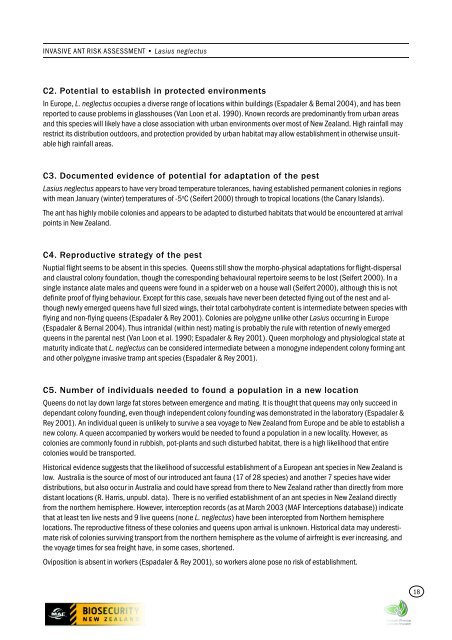Lasius neglectus (A) PEST INFORMATION - Biosecurity New Zealand
Lasius neglectus (A) PEST INFORMATION - Biosecurity New Zealand
Lasius neglectus (A) PEST INFORMATION - Biosecurity New Zealand
Create successful ePaper yourself
Turn your PDF publications into a flip-book with our unique Google optimized e-Paper software.
INVASIVE ANT RISK ASSESSMENT • <strong>Lasius</strong> <strong>neglectus</strong><br />
C2. Potential to establish in protected environments<br />
In Europe, L. <strong>neglectus</strong> occupies a diverse range of locations within buildings (Espadaler & Bernal 2004), and has been<br />
reported to cause problems in glasshouses (Van Loon et al. 1990). Known records are predominantly from urban areas<br />
and this species will likely have a close association with urban environments over most of <strong>New</strong> <strong>Zealand</strong>. High rainfall may<br />
restrict its distribution outdoors, and protection provided by urban habitat may allow establishment in otherwise unsuitable<br />
high rainfall areas.<br />
C3. Documented evidence of potential for adaptation of the pest<br />
<strong>Lasius</strong> <strong>neglectus</strong> appears to have very broad temperature tolerances, having established permanent colonies in regions<br />
with mean January (winter) temperatures of -5 o C (Seifert 2000) through to tropical locations (the Canary Islands).<br />
The ant has highly mobile colonies and appears to be adapted to disturbed habitats that would be encountered at arrival<br />
points in <strong>New</strong> <strong>Zealand</strong>.<br />
C4. Reproductive strategy of the pest<br />
Nuptial flight seems to be absent in this species. Queens still show the morpho-physical adaptations for flight-dispersal<br />
and claustral colony foundation, though the corresponding behavioural repertoire seems to be lost (Seifert 2000). In a<br />
single instance alate males and queens were found in a spider web on a house wall (Seifert 2000), although this is not<br />
definite proof of flying behaviour. Except for this case, sexuals have never been detected flying out of the nest and although<br />
newly emerged queens have full sized wings, their total carbohydrate content is intermediate between species with<br />
flying and non-flying queens (Espadaler & Rey 2001). Colonies are polygyne unlike other <strong>Lasius</strong> occurring in Europe<br />
(Espadaler & Bernal 2004). Thus intranidal (within nest) mating is probably the rule with retention of newly emerged<br />
queens in the parental nest (Van Loon et al. 1990; Espadaler & Rey 2001). Queen morphology and physiological state at<br />
maturity indicate that L. <strong>neglectus</strong> can be considered intermediate between a monogyne independent colony forming ant<br />
and other polygyne invasive tramp ant species (Espadaler & Rey 2001).<br />
C5. Number of individuals needed to found a population in a new location<br />
Queens do not lay down large fat stores between emergence and mating. It is thought that queens may only succeed in<br />
dependant colony founding, even though independent colony founding was demonstrated in the laboratory (Espadaler &<br />
Rey 2001). An individual queen is unlikely to survive a sea voyage to <strong>New</strong> <strong>Zealand</strong> from Europe and be able to establish a<br />
new colony. A queen accompanied by workers would be needed to found a population in a new locality. However, as<br />
colonies are commonly found in rubbish, pot-plants and such disturbed habitat, there is a high likelihood that entire<br />
colonies would be transported.<br />
Historical evidence suggests that the likelihood of successful establishment of a European ant species in <strong>New</strong> <strong>Zealand</strong> is<br />
low. Australia is the source of most of our introduced ant fauna (17 of 28 species) and another 7 species have wider<br />
distributions, but also occur in Australia and could have spread from there to <strong>New</strong> <strong>Zealand</strong> rather than directly from more<br />
distant locations (R. Harris, unpubl. data). There is no verified establishment of an ant species in <strong>New</strong> <strong>Zealand</strong> directly<br />
from the northern hemisphere. However, interception records (as at March 2003 (MAF Interceptions database)) indicate<br />
that at least ten live nests and 9 live queens (none L. <strong>neglectus</strong>) have been intercepted from Northern hemisphere<br />
locations. The reproductive fitness of these colonies and queens upon arrival is unknown. Historical data may underestimate<br />
risk of colonies surviving transport from the northern hemisphere as the volume of airfreight is ever increasing, and<br />
the voyage times for sea freight have, in some cases, shortened.<br />
Oviposition is absent in workers (Espadaler & Rey 2001), so workers alone pose no risk of establishment.<br />
18
















